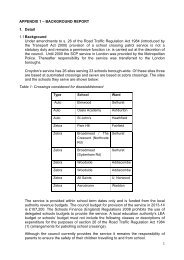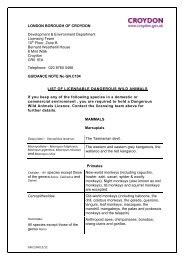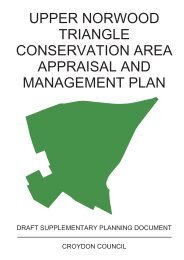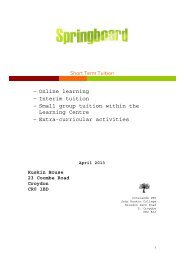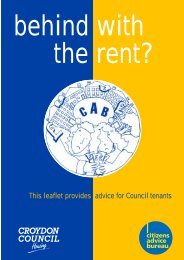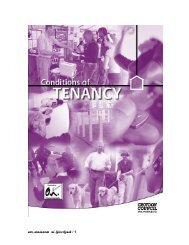PROPOSED MODEL FOR THE SUBSTANCE MISUSE TREATMENT ...
PROPOSED MODEL FOR THE SUBSTANCE MISUSE TREATMENT ...
PROPOSED MODEL FOR THE SUBSTANCE MISUSE TREATMENT ...
Create successful ePaper yourself
Turn your PDF publications into a flip-book with our unique Google optimized e-Paper software.
<strong>PROPOSED</strong> <strong>MODEL</strong> <strong>FOR</strong> <strong>THE</strong><strong>SUBSTANCE</strong> <strong>MISUSE</strong> <strong>TREATMENT</strong> SYSTEM <strong>FOR</strong> CROYDONIn Croydon, we are aiming to commission a treatment system that will:• help people to recover from dependency on drugs and alcohol• enable service users to reintegrate into the communityTo help us do this, we are undertaking a variety of activities to understand the needs in Croydonand are asking for views on our proposals. This will inform the structure of the drug and alcoholtreatment system that we commission.The outcomes from redesigning our treatment system include:• A cost benefit to the community• A reduction in crime• An improvement in individual health• An improvement in public health• Better access to training, education, employment and housing for service usersThe closing date for this survey is 6 September 2013. More information regarding the finalproposed model will be available on our website from November 2013.Please read the Proposals below and complete the on line survey to give us your views on theseproposalsThe proposed model is made up of three distinct services and we would like your views on each ofthese services.Page 1 of 5
This is a diagram ofthe proposed drug & alcohol treatment and recoverysystem forcroydon.The detail is on the following pages with questions..Service ACriminal Justice andDrug and AlcoholHealth servicesServicee BHazardous andharmful alcoholusers andnonuseopiateService CPeer ledrecovery serviceSERVICEAEngagement, medically assisted structured treatment and a criminal justice service.Aims and Objectives• To provide an engagementt and treatment service to thosee who are experiencing difficultieswith their drug and or alcohol use andd are requiring medical interventions to achieverecovery and re-integration.• To reduce the harm of drugand alcohol use• To create a culture of optimism and belief in recovery• To increase numbers of service userss into treatment• To deliver a flexible servicee to meet the needs of service users u requiring interventions• To provide a service that recognises the differing needs of the community.• Delivertraining toprofessionals• To ensure servicee users’ views aboutt their treatment are heard h and respondedd toPage2 of 5
Engagement• Arrest referral• Through-care and after-care for service users leaving prison• Integrated offender management• Restrictions on bail• Outreach• In-reach• Hospital liaison service for drugs and alcohol• Direct access via drop-in service• Triage, comprehensive assessment and care planning• Harm minimisationTreatment• Opiate prescribing and community detoxification• Alcohol detoxification• Psychosocial interventions• Key-working• Group work• Drug Rehabilitation Requirement groups• Alcohol Treatment Requirement groups• Blood Borne Virus testing and vaccination• Primary Care Team for both alcohol and opiates• Access to residential detoxification and rehabilitation (via LA funding panel)• Extensive partnership working including adult safeguarding, hidden harm, mental health,older people, housing and criminal justice services.• To lead on opiate prescribing under 18• Complementary therapiesRecovery• Working in partnership with the recovery & re-integration support service.• Service user representatives are integral to developing, implementing and delivering theservice.• To provide support to family/carers of the service users• To develop a system of volunteers/peer mentors to support service delivery• To ensure that the workforce have a detailed understanding of steps that need to be takento achieve recovery and support required to sustain ongoing recoveryPage 3 of 5
Aims and ObjectivesSERVICE BEngagement, non-medical structured interventions• To provide an engagement and structured treatment service to:‣ harmful and hazardous alcohol users‣ primary cannabis, cocaine and crack users‣ legal highs‣ over the counter medication not requiring medical interventions• To reduce the harm of drug and alcohol use• To increase numbers of service users into treatment• To deliver a flexible service to meet the needs of service users requiring interventions• To provide a service that recognises the differing needs of the community.• To create a culture of optimism and belief in recovery• Deliver training to professionals• To ensure service users’ views about their treatment are heard and responded toEngagement• Outreach and out-reach in partnership with other service providers inside and external tothe treatment system• Direct access via drop-in service• Triage, comprehensive assessment and care planning• Harm minimisation• Partnership workingTreatment• Psychosocial interventions• Key-working• Group work• Access to Blood Borne Virus testing and vaccination• Access to residential detoxification and rehabilitation (via LA funding panel)• Extensive partnership working including adult safeguarding, hidden harm, mental health,housing and criminal justice.• Complementary therapiesRecovery• Working in partnership with the recovery & re-integration support service.• Service user representatives are integral to developing, implementing and delivering theservice.• To provide support to family/carers of the service users• To develop a system of volunteers/peer mentors to support service delivery• To ensure that the workforce have a detailed understanding of steps that need to be takento achieve recovery and support required to sustain on going recoveryPage 4 of 5
SERVICE CRecovery & Reintegration Support ServiceAims and Objectives• To sustain and maintain on going recovery from using drugs and alcohol problematically• To effect reintegration into living a positive, healthy lifestyle• To minimise the risk of returning into the treatment system• To promote the rights and responsibilities of service users• To contribute to consultations about treatment• Deliver training to professionals• To ensure service users’ views about their treatment are heard and responded toElements of Service Delivery• Peer mentor service• Peer Support drop in and relapse prevention• Partnership working with other specialist drugs and alcohol services• Family/carer support• 12 step Fellowship meetings• Information about accessing training and volunteering opportunities• Support around access and information on welfare benefits• Employment support• Debt advice• Health, nutrition, fitness, leisure – new social networks• Housing advice• Self-help, personal development• Access to IT• Complementary therapiesPage 5 of 5



